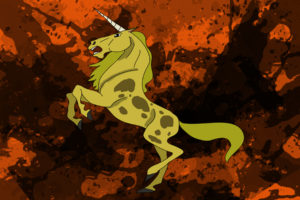Unicorn
Wild unicorns were swift, regal, and proud creatures that had to be treated with respect. A group was called a “blessing.” They were predominately used for sport. White unicorns were prevalent on Fabella, but unicorns could come in a variety of different colors. Horns were made of the same hard bone found on fauns and abada. A full grown horn measured about 1 – 1.5 meters (3 -5 ft.) long. These horns were normally used for defense purposes. Unicorns maintained their horns by rubbing them against the bark of trees. Uncleaned horns could get brittle, dull, and be covered in moss.
Unicorns, like any animal in the equine family, were classified by several names depending on their age and gender. These were: “foal” (any sex < 1 yr.), “yearling” (any sex 1 -2 yrs.), “colt” (male < 4 yrs.), “filly” (female < 4 yrs.), “stallion” (male), and “mare” (female). Stallions and mares mated by first gently touching horns. Mares gave birth to one foal at a time. Foals’ horns started out as blunt little stubs. By the time they became yearlings, their horns began to take on the classic long spiral shape.

